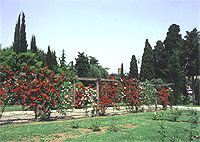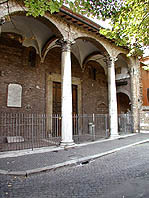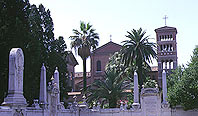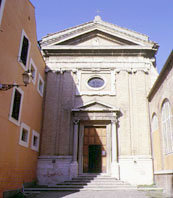Aventine Hill
Aventine
 One of the seven hills of Ancient Rome, where the top brass moved when the Emperors took over the Palatine Hill.
One of the seven hills of Ancient Rome, where the top brass moved when the Emperors took over the Palatine Hill.
Today it is still an attractive residential area and there are some great private houses hidden among the pine trees, as well as a fine church or two.
Rose Garden. In reality two gardens stuffed with roses, with a splendid view of the Imperial Palace on the Palatine across the valley of the Circus Maximus. Massive blooming occurs in late April and through May, with perfume wafting in the air as you walk under the bowers. Open 9-19, May/June.
Piazzale Romolo e Remo, entrance Via di Valle Murcia, 7. Open 9-19, May/June.
Orange Garden or Parco Savelli. 10C walled fortifications were later made into the stronghold of the Savelli family (13C) which dominated this hilltop, just as other families built castles for themselves in various parts of Rome. The bucolic garden has views across the river to the Janiculum hill, St. Peter's, and Monte Mario (yet another hill, with the city's Observatory).
St. Sabina
 Many alterations have been wrought on this church, not all felicitous. Pope Honorius III Savelli added cloisters for Dominican monks in the 13C.
Many alterations have been wrought on this church, not all felicitous. Pope Honorius III Savelli added cloisters for Dominican monks in the 13C.
Sixtus V, in the late 16C, had Fontana alter the interior to a typical Counter Reformation over-blast. Ancient crenellations were removed in the 17C. Finally, Baroque drowned this ancient church.
Bell tower (campanile). 10C.
Inside. Early vestiges: Front door of carved cypress is from the original 5C church. These scenes are from the Old and New Testaments. Top left shows the oldest representation of the Crucifixion - though Christ on the Cross is not visible (it was such a painful death that for centuries it was never shown).
5C mosaic over the front door. This blue and gold art work is all that remains of the lavish four wall mosaic coverage that was destroyed during the "upgrading" in the 16C.
It shows Jews who had converted to Christianity, St. Augustine, and an inscription of the old dedication by Bishop Peter of Illyria. In the middle of the nave is the only mosaic tombstone in Rome of a Dominican Master General (13C).
16C mosaic by Taddeo Zuccari (1529-66), a famous painter from a family of painters. In the south aisle is a fragment of an antique 3-4C column discovered in the house under the church.
|
St. Sabina
History 117-138 AD. During Emperor Hadrian's reign, a Christian maiden called Sabina who lived on the Aventine Hill, perhaps here, was martyred in Umbria. 5C. Bishop Peter of Illyria built a church dedicated to Sabina where he used to hold masses in a private house (Christians in the early days used to worship in small groups at believers' houses). |
Piazza Pietro d’Illiria
St. Alessio
(1217) The Church of St. Bonifacio who became St. Alexis (ring the bell if the door is closed.) Seven young men of Florence saw a vision of the Virgin and became hermits, founding the Order of the Servites. Alexis outlived them all, dying at the amazing age of 101.
The Crescenti family had built a convent next door in the 10 C. The church was modernized inside in 1750, but two small mosaic columns of much earlier vintage are on either side of the bishop's throne. On the west end of the left aisle is a remnant of the wooden stair under which St. Alexis lived and died.
Priorato di Malta
The Residence of the Grand Master of the Order of the Knights of Malta. There is a wonderful view of St. Peter’s through the keyhole of the outer wooden door.
St. Anselmo

1892-96. Pope Leo XIII built this as an International College for the Benedictines.
Their Gregorian chants are enchanting. The Dalai Lama has stayed in the monastery wing while visiting Rome.
Via di Porta Lavernale
St. Prisca

Aquila and his wife Priscilla (or Prisca) mentioned in the "Epistles of Paul" were said to have lived here, welcoming St. Paul on this spot (both he and Aquila were Jewish tent makers).
The area became a Christian cemetery in the early 5C and a church was added 2 centuries later. Priests from it attended Church Councils (in 499 and 595).
In the Middle Ages it was one of the 20 abbeys of Rome. It was reconstructed in the 17C and 19C.
Beneath the church. A nymphaeum with a small museum, crypt and a 2C Mithraeum, Temple of the military god Mithras, were discovered in 1933.
Frescoes and a statue of Mithras killing the Bull were found 15 years later. 1C houses have been found here, some attributed to Emperor Trajan and his friend Licinius Sura.
Via di S. Prisca
St. Saba
Church with a motley history.
|
St. Saba
History 5C. St. Sylvia, mother of St. Gregory the Great, retired here when widowed. 532. St. Saba or Sabbas, a Turkish abbot from Palestine, died in Jerusalem. This church was dedicated to him. 7C. Oriental monks, fleeing Arab and Persian invasions of Palestine, took refuge here, making this the oldest Eastern monastery in Rome. |
Interior. On the left is a fresco of the life of St. Nicholas of Bari. One scene shows three young ladies lying naked in bed.
These young maidens were of a good family and their penniless father was in despair seeing no future for his dowerless daughters. St. Nicholas, aware of their predicament, one night threw a bag of gold through their window, thus giving them dowries - and giving us Santa Claus!
Piazza G. L. Bernini, 20